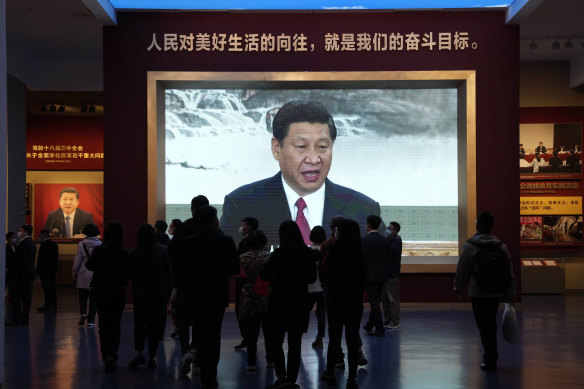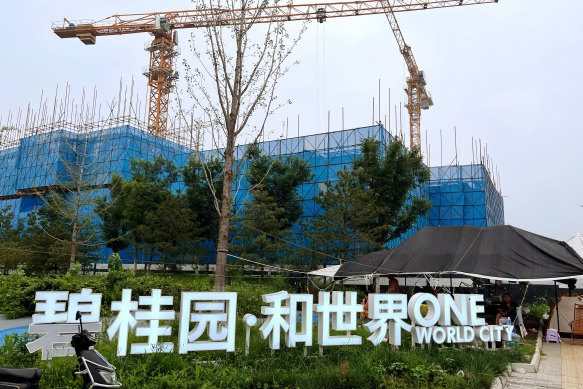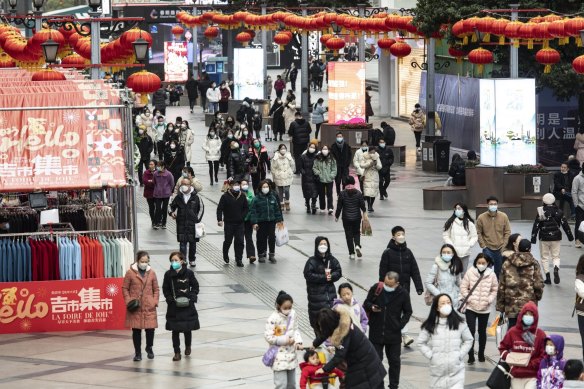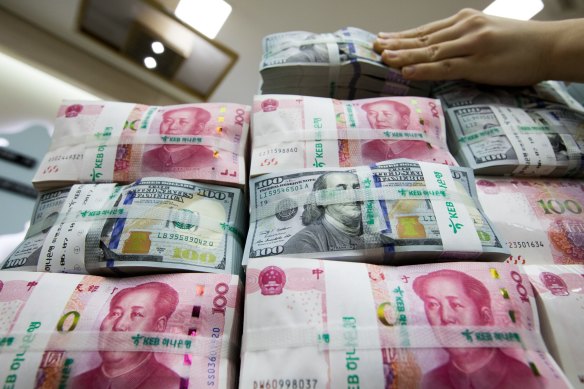Save articles for later
Add articles to your saved list and come back to them any time.
China’s financial system is one step away from a full-blown crisis. Unless radical action is taken to stem contagion through the shadow banks and halt the contractionary slide in demand, China risks tipping into a classic liquidity trap.
Cai Fang, a rate-setter at the central bank, has called for a $US550 billion ($859 billion) blast of helicopter money – or high-powered QE injected into the veins of the economy – in order to stop a deflationary psychology taking hold as frightened households retrench.
It is far from clear that Xi Jinping has recognised the destructive mechanisms at work in China.Credit: AP
“The most urgent imperative now is to stimulate consumer spending. It is necessary to use all reasonable, legal, and economically viable channels to put money into people’s pockets,” he wrote on China Finance 40, the opinion forum of the elite.
This increasingly feels like the make-or-break moment faced by the US Treasury in 2008 after Lehman Brothers collapsed, or faced by the eurozone in 2012 when the doom-loop threatened to engulf Italy and Spain.
America and Europe acted in time, after a string of errors.
It is far from clear that Xi Jinping has recognised the destructive mechanisms at work in China, or that economists in the West are alert to the global dangers through multiple channels of transmission, starting with an exchange rate shock.
The yuan has fallen to a sixteen-year low against the dollar. The East Asian currency bloc is falling in tandem, pushing the euro trade-weighted index to a record high.
The effect is to bludgeon a eurozone economy already in a deep industrial recession. The cheaper the yuan, the greater the tsunami of Chinese electric vehicles, machinery, or wind turbines, heading for Europe.
Westerners emerged from the pandemic with windfall savings, thanks to furlough schemes.
The Chinese endured draconian lockdowns for three years with far less support. The damage has undermined the finances of millions of small family businesses. A large chunk of the population has slashed spending in order to rebuild depleted savings.
Property giant Country Garden is on the edge of collapse.Credit: Reuters
It is the immediate reason why the post-pandemic rebound has already fizzled and why the economy has tipped into deflation. The deeper reason is the painful unwinding of the great Communist debt bubble, an episode uncannily similar to the debt woes of the late Qing dynasty.
The giant developer Country Garden, with total liabilities of $USUS200 billion, is days away from default after missing payments on dollar loans issued in Hong Kong.
Ting Lu and Jing Wang from Nomura estimate that the company has already received payment for a million properties that have yet to be built.
Like other developers relying on China’s “pre-sale” model it depends on a constant flow of new buyers to cover old debts.
The property bubble is the Ponzi scheme that keeps China’s local governments afloat.
The buyers have dried up. The CRIC Research Centre says sales in July by the top-100 developers were just 30 per cent of levels three years ago.
“We believe the Chinese economy is faced with an imminent downward spiral with the worst yet to come,” they said, warning that half-hearted tinkering by the authorities so far will not stop a wave of defaults and chain-reaction through the economy.
“In our view, Beijing should play the role of lender of last resort to support major developers and financial institutions in trouble, and should play the role of spender of last resort to boost aggregate demand,” it said.
China’s $US60 trillion property edifice is by far the largest asset class in the world.
It accounts for half of the world’s entire property sales, an astonishing figure given that China’s workforce is already contracting and net migration from the countryside has stopped.
Xi Jinping’s government is desperate for its consumers to start spending.Credit: Bloomberg
China Evergrande Group sought Chapter 15 bankruptcy protection in New York on Thursday, a move that protects its US assets from creditors while it works on a restructuring deal elsewhere.
The developers have debts of $US5 trillion. By comparison, this is six times greater than America’s $US800 billion subprime property debt on the eve of the Lehman crisis.
They rely heavily on the $US3 trillion “trust” segment of the shadow banking nexus known, which has no lender of last resort. These trusts are starting to blow up. The $US140 billion Zhongzhi Empire is the most disturbing casualty so far.
The property bubble is the Ponzi scheme that keeps China’s local governments afloat.
They rely on property for 38 per cent of total revenue, mostly from land sales. These sales have collapsed. The finance ministry says local government income fell 21 per cent in the first half of 2023.
This must lead to a severe fiscal squeeze unless Beijing comes to the rescue with a huge stimulus package stimulus. The signs are that Xi Jinping is still reluctant to do so.
His allies have published a media note entitled “Clarifying the Eight Misconceptions about Expanding Domestic Demand”.
Xi faces an invidious choice. Hurling credit at the deformed Chinese economy every time the sugar rush fades and the economy slows is what has led to this colossal mess, but biting the bullet risks an economic depression and a crisis of legitimacy for the Communist Party.
His immediate reflex is to silence unpleasant statistics. Youth unemployment data has been suspended after the rate jumped to a record 21 per cent.
A Beijing professor thinks the rate is nearer 46 per cent once you include those “lying flat”, the Chinese term for dropping out, living at home, and sponging off grandparents (four per child) to while away the day with friends in coffee shops.
The Party’s first mistake was to ignore warnings by premier Li Keqiang a decade ago that China risked falling into the middle income trap if it clung too long to a catch-up model of state-led construction.
The second mistake was to launch a political purge against business bosses and turn away from Deng Xiaoping’s outward-looking economics, the motor force of China’s revival.
The third was to revert to economic Leninism, thinking that 2008 was a systemic crisis of US-led capitalism and a validation of Party control over credit.
The yuan has fallen to a sixteen-year low against the dollar.Credit: Bloomberg
The fourth was to pick a fight with the liberal West before China was close to economic parity.
The evidence is in. The growth rate of total factor productivity has fallen to the levels of mature economies before China is mature.
The country is no longer on the same trajectory as Japan, Taiwan, and Korea at a comparable point of development. The nail in the coffin is an 87 per cent fall in foreign direct investment last quarter, the lowest level since records began in the 1990s. That is Xi’s legacy.
Capital Economics thinks China’s (true) trend growth will drop to 2.8 per cent over the late 2020s. If so, China will not surpass the US this decade, and will then fall back as the demographic decline gathers pace.
China denies vehemently that it is succumbing to ‘Japanification’.
In my view, it will be lucky to do as well as Japan. It has the same pathologies of boom-bust deflation and vanishing workers, but is further blighted by totalitarian leaders with a deep fear of the free market.
Unlike Japan, it has angered the West and must now contend with strategic reshoring and a hi-tech blockade.
Joe Biden calls China’s economy a “ticking time bomb”.
My presumption is that Xi Jinping will not let it detonate on his watch. At some point he will blink and take drastic action to shore up the property market and the shadow banks, putting off the day of reckoning for another cycle.
If he does not, the global financial system is in for a dangerous denouement this winter.
The Business Briefing newsletter delivers major stories, exclusive coverage and expert opinion. Sign up to get it every weekday morning.
Most Viewed in Business
From our partners
Source: Read Full Article




